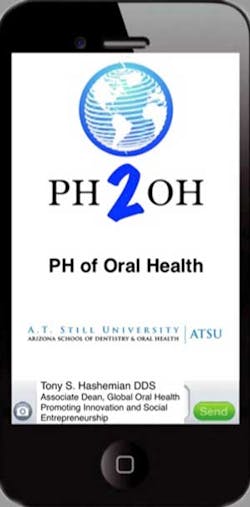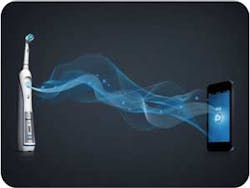Now there is a way to jazz up your day-to-day routine with new protocols and cool technology tools for your patients’ overall health. By 2017, half of the 3.4 billion smartphone and tablet users worldwide will use mobile applications to focus on health and wellness 360. (1)
ADDITIONAL READING |The tidal wave of saliva research
To address this health initiative, dental professionals need to add Bluetooth technology oral health and oral care apps—such as PH2OH saliva pH testing and Oral-B Bluetooth brushing apps—to their patient protocols.
The PH2OH app is a saliva-testing examination tool developed by Tony Hashemian, DDS, associate dean of the Global Oral Health program at the Arizona School of Dentistry and Oral Health (ASDOH). The pH stands for potential hydrogen with a range of 0–14. The higher the number indicates alkalinity and lower acidity. The body does not tolerate extended acid imbalances by exhibiting early symptoms of headaches, allergies, colds, and flu symptoms.
ADDITIONAL READING |“Making the oral-systemic connection” blog by Richard H. Nagelberg, DDS
The good news is, if you keep your body in a neutral pH, it has a stronger immunity to disease. Most Americans, however, have a pH level of 6.2–6.4. Advancements in immunology, microbiology, and biochemistry suggest salivary testing may prove to be a predictable way for dental professionals to identify oral signs of systemic diseases. (2)
Studies indicate that saliva testing may be useful for detecting heart disease, GERD (acid reflux), diabetes, and other conditions. (3, 4) Research has also shown pH saliva testing to detect nutritional deficiencies, immune disorders, breast cancer, oral cancer, periodontal disease, general infections, and systemic disease that can affect the entire body. (5, 6)
Saliva is also one of the body’s most effective means for protecting the tooth enamel against acid. It is important to have adequate saliva, because if the pH drops below 5.5, tooth decay can occur. Saliva protects against dental caries, erosion, attrition, periodontal disease, candidiasis, and abrasive mucosal lesions. An understanding of the salivary environment is critical to achieve long-term health for our dental patients.
Which patients should we recommend saliva testing for and when?
• New patients—record a baseline and monitor
• Perio patients—those with unexplained caries or newly diagnosed with periodontal disease
• Current patients—prior to orthodontics, implant, or restorative treatments
• High-risk patients—prior to other medical treatments
Salivary testing can be a valuable tool in our dental professional toolbox to educate patients, for preventive health treatment planning, and to assist with proper selection of dental home-care products to initiate changes in patients’ oral and overall health.
Patients can now use their smartphone or tablet with the free PH2OH app for iPhone or Android to record their pH value (figure 1). Patients capture a picture of the litmus paper test strip after testing their pH, and auto or manually calculate the pH using color-coding analysis. They can save the data and track their pH reads in their smartphone to share with their health professionals.
Instructions for your patients on how to use the PH2OH app:
1.Download the PH2OH app, free from the iOS App/Google Play store.
2.Place one end of the litmus paper into the mouth to contact saliva; lay on paper towel for 30 seconds or spit into a medicine cup; place one end of litmus paper in the cup to draw the saliva onto the paper. Remove and lay on paper towel for 30 seconds.
3.Using the PH2OH app, check your litmus paper results with the pH wheel; save the read; and record on the history graph. It will list the time and date of your pH read.
4.Show the results to your hygienist, dentist, or doctor to assist in a better diagnosis and for good home-care tips for your oral health.
What is the pH of your patient’s saliva? Is it acidic, basic, or neutral? To read a pH saliva reading on the litmus paper, refer to the pH color-coded guide by GC America.
Instructions for dental professionals on how to read your patient’s saliva pH from the PH2OH app:
• 6 or below = acidic
• 7 = neutral
• 8 or above = alkaline = healthy patient
Dental professionals can take this information and recommend good home-care routines as they seek to promote oral-systemic health. If the patient’s pH test is 6 or below, have the patient apply a pea-sized amount of MI Paste (GC America), and leave it undisturbed for three-to-five minutes to bring the pH value up to neutral.
Procter & Gamble (P&G)/Oral-B also introduced the world’s first Bluetooth-connected toothbrush with two-way interactivity with an oral-care app to motivate patients to brush correctly for a full two minutes and store the data on patients’ oral-care routines (figure 2).
Patients can download the Oral-B brush app from the iOS App/Google Play stores to enable real-time feedback while brushing with reminders for tongue cleaning, flossing, and mouth rinsing included. Dental professionals can personalize a brushing routine for patients along with their next appointment, right on their own smartphones.
Connected oral health increases patients’ oral and overall health awareness in a cool way. Dental professionals can evaluate the data collected through these apps to initiate changes in patients’ oral health routines for better overall health.
Elevate your oral health recommendations with new technology tools to evaluate, motivate, and enhance patients’ home care for health and wellness 360!
For more information, visit the websites for the PH2OH app and the Oral-B oral care app. To participate in my “Saliva, Technology, & All That Jazz” presentation, join me and other dental professionals on the Smiles at Sea New Orleans Cruise, September 22–26, 2016. Visitsmilesatsea.com for details.ALSO BY SUSAN WINGROVE | Manage, repair, or regenerate periodontal disease?References
1. Tilenius S. Will an app a day keep the doctor away? The coming health revolution. Forbes website.forbes.com/sites/ciocentral/2013/09/08/will-an-app-a-day-keep-the-doctor-away-the-coming-health-revolution. Published September 8, 2013.2. Lawrence HP. Salivary markers of systemic disease: noninvasive diagnosis of disease and monitoring of general health. J Can Dent Assoc. 2002;68(3):170–174.3.Devi TJ. Saliva: a potential diagnostic tool. J Dental Med Sci. 2014:13(2):52–57.4.Gopinath VK, Arzreanne AR. Saliva as a diagnostic tool for assessment of dental caries. Arch Orofacial Sci. 2006;1:57–59. 5. Streckfus CF, Bigler LR. Salivary glands and saliva; saliva as a diagnostic fluid. Oral Dis. 202;8:69–76.6.Lee JM, Garon E, Wong DR. Salivary diagnostics. Orthod Cranioffac Res. 2009;12:206–211.This article first appeared in the newsletter, DE's Breakthrough Clinical with Stacey Simmons, DDS. Subscribe here.









